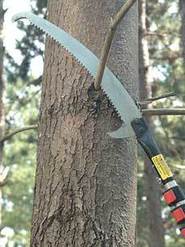 For the past several weeks white
pine trees have been a lively topic of conversation. If you are growing white pine
in your woods, you may want to take steps to improve the future timber value of
your best trees. Pruning is a good way to
do that. Pruning means
removing branches of a standing tree flush with the outside of the branch
collar.
Why
prune white
pine? Pruning can improve the health and appearance of a tree, and increase its
commercial value. Pruning trees destined for a lumber mill can be very
profitable. Pruning improves value by
increasing the amount of knot-free wood (think clear pine boards) in the tree.
Pruning can also reduce
the potential for damage from disease agents such as white pine blister rust, which often enters a tree through a lower
limb.
It is
best to begin pruning white pine when trees are young and the branches are
small. This allows the most clear lumber to grow on the bole, since knots form
as each year's new growth surrounds a living or dead branch. Also, it is easier, more efficient and
healthier for the tree to prune small branches rather than to prune large
limbs. Wait to prune pine until the main stem is at least 4 inches in diameter at
a point 4-1/2 feet above the ground. (This is also referred to as diameter at
breast height, or “DBH.”) Pruning operations may be repeated regularly until
the lower 17’ to 25' of the bole (higher on very productive trees) has been
pruned. However, never remove more
than 1/3 of the live crown at any time.
It’s
a good idea to keep records of which trees are pruned and when. Some woodland
owners even notarize this information. That way, years from now when the trees
are harvested for saw logs, there is proof of how much clear lumber a mill can
expect. Pruning records can be very useful in negotiating a good price for saw
logs.
For the best return on
the effort, prune only dominant trees with healthy crowns that receive direct
sunlight on their tops and at least partial sunlight on their sides. These “crop” trees should
be released from competition before they are pruned. Without room
to grow, many pruned potential crop trees may decline or drop out out of the
stand before they have a chance to produce enough clear wood to justify the
work of pruning. One good criterion for choosing trees to prune should be a
strong likelihood to maintain or increase growth for at least another 20
years.
Trees with straight, upright trunks, and no splits, forks, other defects,
or branches larger than 2 inches in diameter in the lower 9 to 17 feet of trunk
are the best candidates for pruning. These trees should be at least 4 inches at DBH and no more than 12 inches
at DBH, although exceptionally thrifty, dominant, small limbed pines up to 16 inches DBH could be considered. A lot depends on the amount of growth expected
after pruning, which directly affects the amount of clear wood produced.
Marking trees before pruning will save time and labor
costs. Never prune with an ax. Use a pruning saw. Small dead branches and branches within 6
feet of the ground are easily removed with a hand saw. A lightweight power saw
in skilled hands is effective on lower branches, but care must be used to avoid
damaging the bole. For safety, do not attempt to prune higher limbs with a
power saw. Prune to the desired height with a good pole pruning saw. Always use
a hard hat and eye protection when pruning. Even a small limb can hurt when it
falls from 16 feet up.
For more details, check
out Maine Forest Service
Information Sheet # 23, “Pruning White Pine.”
As
always, you
can call the Maine
Forest Service for more information or assistance at 1 800 367-0223
(in state) or (207) 287-2791, or e-mail forestinfo@maine.gov
|